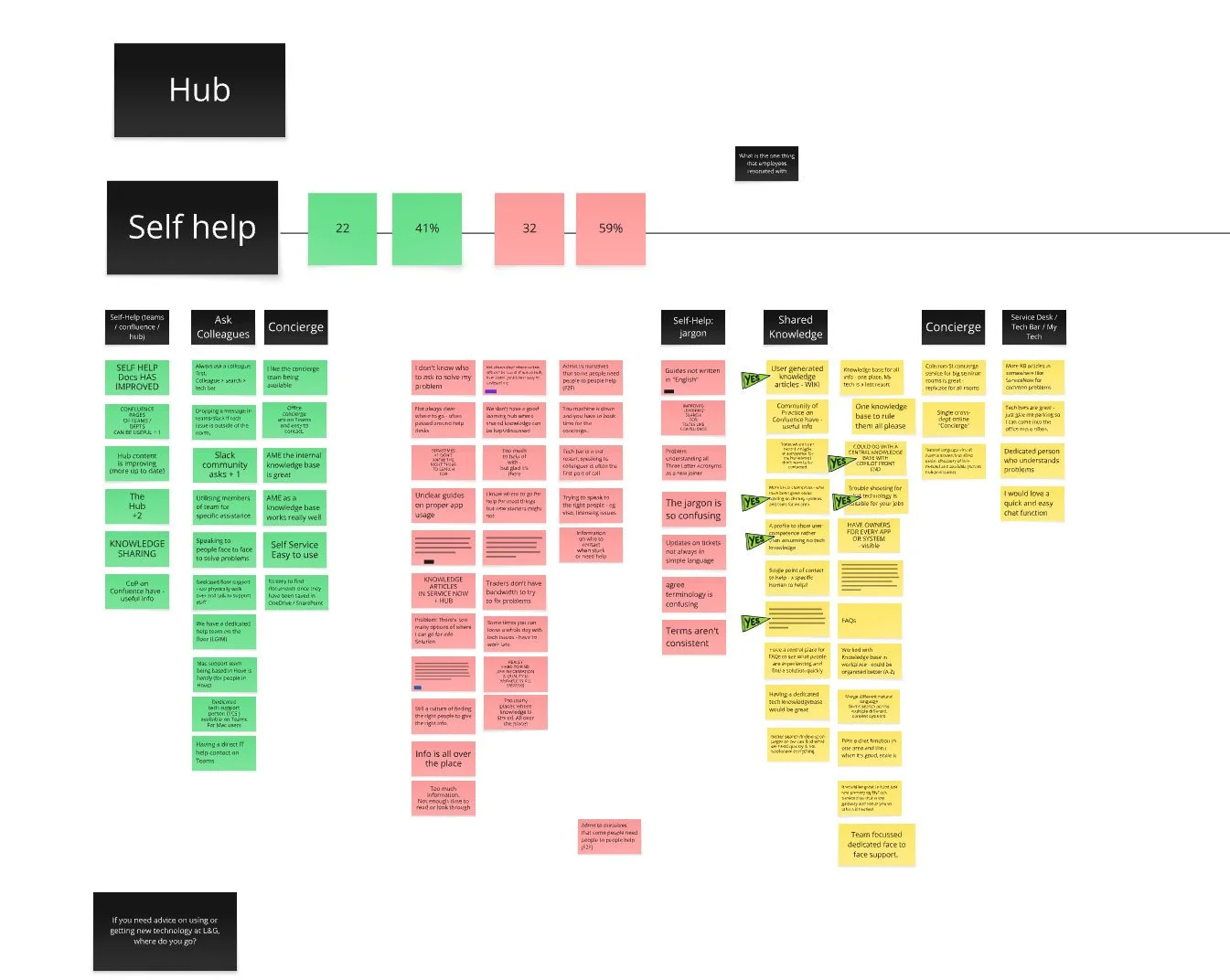Legal and General
Designing smarter, simpler workdays for L&G employees
Services:
Digital Strategy, Service Design, Research, UX
As part of a research programme into how employees use digital tools at Legal & General, I set out to identify the moments that matter in their day-to-day work and uncover opportunities to improve their experience.
The problem
Employees were struggling with fragmented systems, unclear processes, and inconsistent support. Many tools were designed around internal business structures rather than employee needs, making it difficult to find information, get help, or complete simple tasks.
Approach
I planned and ran generative research sessions with colleagues across the business to understand and validate some of the previously found problem areas.
Digital Day in the Life (face-to-face and virtual)
Over 230 employees from a wide range of roles and grades took part - face to face While many participants were from the Digital Experience team (with higher digital literacy), we ensured a broad mix of perspectives.
Intranet specific research - Kano studies, moderated discussions and unmoderate usability tests..
This combined with data from company wide ‘Listening surveys’ and ‘Tech bar metrics’ gave us a good starting point.
Key Themes Identified
After analysing the data, the findings were grouped into five main categories:
Standardisation and Centralisation (out of scope)
My HR (out of scope)
Training and JML (Joiners, Movers, Leavers) process
Tech Support
Comms, Content and Search
Areas identified where we could have influence to create meaningful impact.
Although many of the digital tools in use were third-party solutions and beyond our direct control, we conducted a comprehensive mapping of user pain points across each platform.
Collaborating closely with the workplace team, we explored strategic opportunities to streamline and enhance the ways employees locate and engage with relevant content, ultimately simplifying digital workflows and elevating the overall user experience.
Employee training
Lack of clear guidance on training options
Inconsistent processes
Disconnected systems for approvals and requests
Comment:
“No one understands where to find the right information.”
To investigate:
Make it easier to find help and log issues (hyper personalisation)
Tech Support
Low confidence in support teams
Issues often unresolved or reoccur
Complex and unclear issue-logging process
Comment:
“Sometimes I end up with a different problem after the first one was fixed.”
To investigate:
Simplify the systems and processes for requesting and finding help (Ai strategy)
Search & Content
Search results often irrelevant or outdated
Information scattered across platforms
Relaiance on colleagues to find solutions
Comment:
“Too much on the Hub when using Search. Not sure if the content is correct or up to date.”
To investigate:
Improve relevance and clarity of results (Ai strategy)
Comms
Important updates lost in a flood of notifications
Too many non-essential messages
No clear hierarchy of communication
Comment:
“Difficult to get to the essential comms as there are too many on non-essential topics.”
To investigate:
Prioritise essential updates and reduce noise (hyper personalisation)
From Insight to Action
Collectively, we prioritised insights into three key workstreams to guide improvements:
1. Product backlog integration
Working with the product owners, I identified actionable insights that could be added directly to existing product backlogs across platforms.
Outcome: Quick wins and small improvements that align with current development work.
Example: Streamlining the software approvals process.
2. Service design and deeper investigation
Some issues needed a broader view across the employee journey. These were flagged for further exploration to understand root causes and how they connect across systems.
Outcome: A clearer understanding of systemic pain points and opportunities for service-level improvements.
Example: Finding out why employees prefer asking colleagues over using official support channels.
3. Design sprints and future visioning
Well-defined insights were used to shape design sprint briefs aimed at creating and testing future-facing ideas. Research outputs led the future Ai strategy for Employee and customer support.
Outcome: Prototypes and validated concepts to guide long-term product strategy.
Example: Improving content relevance across platforms to better support employees throughout their journey.
The outcome
To build momentum and drive meaningful change, we planned an Employee App hackathon and a focused design sprint to accelerate the delivery of a new and improved intranet. Alongside this, I developed a roadmap for enhancing the employee support experience, exploring how AI could be integrated to streamline interactions and improve speed and relevance across touchpoints.


